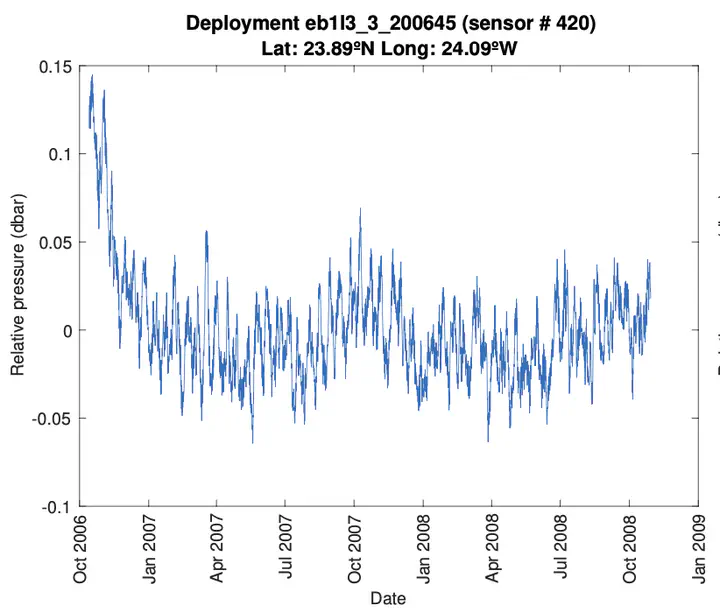Estimating the deep overturning transport variability at 26°N using bottom pressure recorders
 Relative bottom pressures for two deployments from EB1 showing that instrument drift is typically most severe at the beginning.
Relative bottom pressures for two deployments from EB1 showing that instrument drift is typically most severe at the beginning.Abstract
The Atlantic meridional overturning circulation (AMOC) carries almost 90% of the approximately 1.3 PW of heat carried poleward by the North Atlantic. The RAPID mooring array at 26oN in the Atlantic has been monitoring the AMOC since 2004, and its measurements suggest that the AMOC is declining in strength. Most of this decline is due to a weakening of the deep southward return flow. When AMOC transport is estimated, the barotropic transport component is not determined from measurements, but is a residual added to the baroclinic and Ekman transports and the Gulf Stream to ensure a zero net flow across the section. This approach was validated using the first year of RAPID data by estimating AMOC transport with the barotropic transport component directly derived from in-situ bottom pressure (BP) measurements, and finding good agreement with the residual method AMOC estimate. This study will use over a decade of RAPID BP data to estimate barotropic transport at 26oN. BP sensor records commonly show low frequency instrument drift, but the standard method of removal also removes other long period signals. This study used over 10 years of bottom pressure data from both the RAPID array and the Gravity Recovery and Climate Experiment (GRACE) satellite mission, with the GRACE ocean bottom pressure (OBP) data used to remove the instrument drift from the RAPID array BP sensor records, leaving low-frequency signals intact. The GRACE-adjusted in-situ BP data were then used to estimate the barotropic transport variability at 26oN. The detrended barotropic transport estimated from GRACE-adjusted, in-situ BP data correlated well (r = 0.66, p < 0.01) with the residual calculated during the RAPID AMOC calculation, and the two time series were coherent and in-phase for most periods from 10 to 180 days and longer than one year. However when the time series were not detrended, the 10-year trends were in opposition, with the GRACE-adjusted, in-situ BP-derived barotropic transport showing a strengthening southward flow in contrast to the weakening southward hypsometric compensation. In conclusion, using GRACE data to remove instrument drift from in-situ BP sensors appears effective, and the transport derived from the adjusted BP data provides independent verification for the RAPID AMOC calculations. However the GRACE data may itself contain low-frequency signals that are not removed during processing and cause the observed trend.